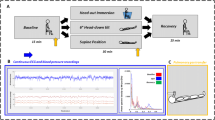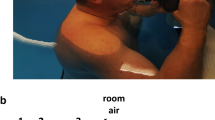Abstract
Five men, aged 31.2 years (SD 2.3), under semi-nude conditions and resting in a dorsal reclining position, were exposed to thermoneutral air for 30 min, followed immediately by a cold water (15°C) immersion for 60 min. Cardiac output was measured using a dualbeam Doppler flow meter. During immersion in cold water, cardiac frequency (f c) showed an initial bradycardia. The lowest values were reached at about 10 min after immersion, 58.3 (SD 2.5) to 48.3 (SD 7.8) beats min−1 (P < 0.05). By the 20th min of exposure,f c had gradually risen to 70.0 beats min−1 (SD 6.6,P < 0.05). This change could be due to the inhibition of the initial vagal reflex by increased catecholamine concentration. Stroke volume (V s) was significantly increased (P < 0.05) during the whole cold immersion period. Cardiac output, increased from 3.57 (SD 0.50) to 6.26 (SD 1.33)1 min−1 (P < 0.05) and its change with time was a function of bothV s andf c. On the other hand, systolic flow acceleration was unchanged during the period of immersion. The changes in the respiratory variables (ventilation, oxygen uptake, carbon dioxide output and respiratory exchange ratio) during immersion showed an initial hyperventilation followed, as immersion proceeded, by a slower metabolic increase due to shivering.
Similar content being viewed by others
References
Arborelius M, Balldin U, Lolja B, Lundren C (1972) Hemodynamic changes in man during immersion with head above water. Aerospace Med 43:592–598
Beckman E, Reeves E (1966) Physiological implications as to survival during immersion at 75°F. Aerospace Med 11:1136–1142
Begin R, Epstein M, Sackner M, Levinsone R, Dougherty R, Duncan D (1976) Effects of water immersion to the neck on plumonary circulation in water at 75°F. Aerospace Med 11:1136–1142
Behnke L, Yaglou P (1951) Physiological responses of men to chilling in iced water, to slow and fast rewarming. J Appl Physiol 3:591–602
Bittel J (1987) Heat debt as an index for cold adaptation in men. J Appl Physiol 62:1627–1634
Bittel J, Livecchi-Gonnot G, Hanniquet A, Poulin A, Etienne C (1989) Thermal changes observed before and after J.L. Etienne's journey to the North Pole. Eur J Appl Physiol 58:646–651
Boutelier C (1973) Thermal exchanges in human body during immersion in water (in French). Thèse Biol Humaine, Lille, pp 215
Boutelier C (1979) Survival and protection of aircrew in the event of accidental immersion in cold water. AGARD-NATO 210:33–34
Boutelier C, Bouges I, Timbal J (1974) Acclimation through immersion in water: changes in metabolism (in French). J Physiol (Paris) 69:230
Colin J, Houdas Y (1965) Human tolerance to cold water and protective clothing (in French). Rev Med Aerospace 13:63–67
Colin J, Houdas Y (1982) Temperature distribution. In: Houdas Y, Ring E (eds) Human body temperature: its measurements and regulation. Plenum Press, New York, p 101
Dejours P, Garey W, Rahn H (1970) Comparison of ventilatory and circulatory flow rates between animals in various physiological conditions. Resp Physiol 9:108–117
Derion T, Guy H, Tsukimoto K, Schaffartzik W, Prediletto R, Poole D, Knight D, Wagner P (1992) Ventilation-perfusion relationship in the lung during head-out of water immersion. J Appl Physiol 72:64–72
Dulac S, Quirion A, De Carufel D, Leblanc J, Jobin M, Cote J, Brisson G, Lavoie J, Diamond P (1987) Metabolic and hormonal responses to long-distance swimming in cold water. Int J Sports Med 8:352–356
Dunnet C (1955) A multiple comparison procedure for comparing several treatments with control. J Am Stat Assoc 50:1096–1121
Evans J, Skidmore R, Luckman N, Well P (1989) New approach to noninvasive measurement of cardiac output, using an annular array doppler technique: II practical implementation and results. Ultrasound Med Biol 15:179–187
Folinsbee L (1974) Cardiovascular response to apneic immersion in cold and warm water. J Appl Physiol 36:226–232
Frey M, Kenney R (1977) Changes in left ventricular activity during apnea and face immersion. Undersea Biomed Res 4:27–37
Gardin J, Dabestani A, Matin K, Allfie A, Russel D, Henry W (1984) Reproducibility of doppler aortic flow measurements: studies on intraobserver, interobserver and day by day variability in normal subjects. Am J Cardiol 54: 1092–1098
Glaser E, Berridge F, Prior K (1950) Effects of heat and cold on the distribution of blood in human body: radiological investigation of the liver, lung and heart. Clin. Sci. 9:181
Hardy J (1961) Physiology of temperature regulation. Physiol Rev 41:521–606
Hattle I, Angelsen B (1982) Ultrasound in cardiology: physical principles and clinical applications. Lea and Febiger, Philadelphia
Hayward J, Hay C, Matthwes B, Overweel C, Radford D (1984) Temperature effect on the human dive response in relation to cold water near-drowning. J Appl Physiol 56:202–206
Horvath S, Spurr G, Hutt B, Hamilton L (1955) Metabolic cost of shivering. J Appl Physiol 8:595–602
Houdas Y, Ring E (1982) Human body temperature: its measurements and regulation. Plenum Press, New York, p 101
Huntsman L, Stewart D, Barnes S, Franklin S, Colocousis J, Hessel E, (1983) Noninvasive doppler determination of cardiac output in man. Circulation 67:593–602
Johansen I, Foldeager N, Stadeager C, Kristensen M, Bie P, Warberg J, Kamegai M, Norsk P (1992) Plasma volume, fluid shift, and renal responses in humans during 12 h of head-out water immersion. J. Appl Physiol 73:539–544
Keatinge W, Evans M (1961) The respiratory and cardiovascular response to immersion in cold and warm water. Q J Exp Physiol 46:83–94
Keatinge W, Nadel J (1965) Immediate respiratory response to sudden cooling of the skin. J Appl Physiol 20:65–69
Knitelius H, Stegeman J (1987) Heart volume during short-term head-down tilt (−6°) in comparison with horizontal body position. Aviat Space Environ Med 58:61–63
Krog J, Folkow B, Fox R, Lange-Anderson K (1960) Hand circulation in the cold of Lapps and North Norwegian fisherman. J Appl Physiol 15:654–658
Krog J, Alvik M, Lund-Larsen (1969) Investigations of the circulatory effects of submersion of the hand in ice water in the Finnish Laps: the ‘Skolt’. Fed Proc 28:1135–1137
Leblanc J (1975) Man in the cold. Thomas, Springfeild, III. pp 99–145
Leblanc J (1988) Factors affecting cold acclimation and thermogenesis in man. Med Sci Sport Exercise 20:193–196
Lohman T, Boileau R, Massey P (1975) Prediction of lean body mass in young boys from skinfold thickness and body weight. Hum Biol 47:245–262
Looyenga D, Liebson P, Bone R, Balk R, Messer J (1989) Determination of cardiac output in critically ill patients by dual beam doppler echocardiography. J Am Coll Cardiol 13:340–347
Major T, Schwinghamer J, Winston S (1981) Cutaneous and skeletal muscle vascular responses to hypothermia. Am J Physiol 240:H868-H873
Mekjavic I, Bligh J (1989) The increased oxygen uptake upon immersion: the raised external pressure could be causative factor. Eur J Appl Physiol 58:556–562
Raven P, Niki I, Dahm T, Horvath S (1970) Compensatory cardiovascular responses during an environmental cold stress (5°C). J Appl Physiol 29:417–421
Rennie D, Di Prampero P, Cerretelli P (1971) Effect of water immersion on cardiac output, heart rate and stroke volume of man at rest and during exercise. Med Sport 24:223–228
Skidmore R, Evans J, Baker D, Wells P (1987) An angle and diameter independent method of measuring non-invasive cardiac output by doppler ultrasound. Am Heart Assoc, 60 Sci 16–19 November Sess. Anaheim, California
Stolwijk J, Hardy J (1977) Control of body temperature. In: Handbook of physiology: reactions to environmental agents. Am Physiol Soc, Woresley Press, Baltimore, Section 9, pp 45–98
Tipton M (1989) The initial response to cold-water immersion in man. Clin Sci 77:581–588
Tipton M, Studds D, Elliott D (1991) Human initial response to immersion in cold water at three temperatures and after hyperventilation. J Appl Physiol 70:317–322
Vogelaere P, Brasseur M, Quirion A, Leclercq A, Laurencelle L, Bekaert S (1990) Hematological variations at rest and during maximal and submaximal exercise in cold (0°C) environment. Int Biometeorol 3:1–14
Vogelaere P, Deklunder C, Lecroart J, Savourey G, Bittel J (1992a) Factors enhancing cardiac output in resting subjects during cold exposure in air environment. J Sports Med Physical Fitness 32:378–386
Vogelaere P, Savourey C, Deklunder G, Lecroart J, Brassuer M, Bekaert S, Bittel J (1992b) Reversal of cold induced haemoconcentration. Eur J Appl Physiol 64:244–249
Winner B (1971) Statistical principles in experimental design. Mc Graw Hill, New York
Author information
Authors and Affiliations
Rights and permissions
About this article
Cite this article
Vogelaere, P., Deklunder, G. & Lecroart, J. Cardiac output variations in supine resting subjects during head-out cold water immersion. Int J Biometeorol 39, 40–45 (1995). https://doi.org/10.1007/BF01320892
Received:
Revised:
Accepted:
Issue Date:
DOI: https://doi.org/10.1007/BF01320892




